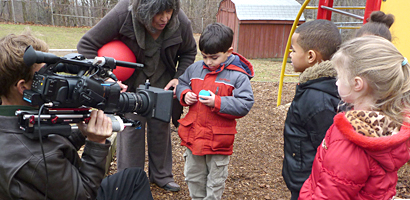Hollywood invaded Tarrytown last month but, in addition to Keanu Reeves and James Caan, another group of big time celebrities performed for the cameras — this time on the grounds of our local Kindergarten — and the stars were the students and teachers of Tappan Hill.
Sid the Science Kid is an educational program promoting exploration, discovery, and science readiness in early childhood. Co-produced by The Jim Henson Company and KCET/Los Angeles, Sid is a part of the popular PBS KIDS morning line-up.
 Though mainly an animated show, it incorporates a small, live-action segment in each episode featuring real kids performing simple science experiments. To produce these live-action segments, The Jim Henson Company hired Rolling River Films, a documentary film production company based in Tarrytown and owned and operated by local documentary filmmaker Camilla Calamandrei.
Though mainly an animated show, it incorporates a small, live-action segment in each episode featuring real kids performing simple science experiments. To produce these live-action segments, The Jim Henson Company hired Rolling River Films, a documentary film production company based in Tarrytown and owned and operated by local documentary filmmaker Camilla Calamandrei.
“The idea of showing real kids is twofold,” explains Calamandrei. “One, live kids intend to inspire [other] kids to want to try it and, in fact, the producers make a big point of making sure we always use materials that could be easily found by a family, so everything we do is easily reproducible by a kid and their family, or a classroom. The other principle is that by showing the real objects, you are seeing a kind of detail and accuracy that you cannot get in an animated piece. So if we’re seeing a ball bounce then we’re seeing the actual response. If we’re seeing a piece of rotted pumpkin, then we’re seeing actually what that looks like.”
This is the second time Calamandrei has filmed Sid the Science Kid at Tappan Hill. She previously shot here in 2008, and those episodes are just now airing on PBS. That experience went so well, she was pleased to have the opportunity to come back. And once again, the shoot was a rousing success. “It went very well, the kids were very cooperative; they’re so sweet at that age,” she says. “The teachers are amazingly patient with us. Everyone’s very accommodating.”
Tappan Hill Principal Michele Milliam was happy to welcome Sid the Science Kid back to her school. “It was actually minimally disruptive, probably less so this time because we knew what to expect.” She says a main factor in helping the film shoot remain unobtrusive is the professionalism of Calamandrei and her crew. “They know exactly what they need, what they want, and how to get it.”
This time around, Calamandrei shot eight different segments for the show at Tappan Hill. Each segment centered on a different scientific theme, such as different properties of light (darkness, color prisms, shadows) or basic physics principles (elasticity, friction, inertia). Kids tackle a different question in each activity that explores one of these themes. So, for example, one segment asks kids, “What makes a rainbow?” while other segments posed questions like “How do differing surfaces slow down an object in motion?” and “Why, when a skateboard stops, do I keep going?”
The children and teachers working in front of the camera are different for each activity, and all come right out of the classrooms of Tappan Hill. “We used eight different teachers, including Mrs. Milliam,” says Calamandrei. “And we used children from eight different classes.” In fact, most of the kids who took part were in scenes along with their own teacher, which made it a more comfortable experience for the children. When I visited the set, Tappan Hill teacher MaryLynn Pearlman was in the back playground with four of her students, preparing to film a segment on elasticity. She had four balls of different sizes and materials, and the question they were to explore was “Which round item will bounce, and which will bounce higher?”
I watched as Calamandrei and her small crew set up their shot behind the school with four children sitting on the four-sided see-saw with Mrs. Pearlman standing in between them. The massive hand-held camera was maneuvered into place, at times mere inches from a child’s face or hands, a large white board was situated to better reflect the sunlight onto the kids, and Calamandrei hovered over a monitor so she could see exactly what the camera was seeing. While the adults stood around waiting for everything to be ready, the children did what children do — they played.
When she was ready, Calamandrei took time out to introduce herself to the kids, and explain just what they were going to be doing. This particular series of shots consisted of each of the kids pressing his or her thumbs into one of the balls to see how easily the ball popped back into shape, thereby testing elasticity. Then Mrs. Pearlman took over and went into teacher mode, going through the experiment with her students as the camera rolled. Mrs. Pearlman’s voice, and the voices of the other teachers and students filmed, won’t actually be heard in the final episode; these segments will eventually be narrated by a voice actor portraying one of the animated characters of the show.
Though none of the students or teachers are paid for their work, they each receive a mention in the credits, as well as a copy of the final episode in which they appear. “We compensate the school for any subs or any expenses that are incurred,” adds Calamandrei. But according to Principal Milliam, there’s nothing financial about her decision to allow the production to film at Tappan Hill. “I think the overall benefit is more to do with the PBS show,” she says. “One of the reasons why I agreed to do it again is because it is a relatively easy way for us to support a program that we really value and that we think is done tastefully, appropriately, and teaches something in a way that is compatible with how we teach.”
The episodes that were being filmed are set to air on PBS this September, at which point Calamandrei hopes to return to Tappan Hill to film 8-12 more segments, a proposal which Principal Milliam heartily endorses.
As the production crew took a break to set up the next shot on this beautiful winter day under a cloudless sky, I approached the four burgeoning actors as they snacked on a craft services offering of pretzels to see how they were taking to the brutal reality of filmmaking. Overall, they seemed to be enjoying themselves. “The fun part about doing this is when you drop the ball and you see how high it bounces,” said one of Mrs. Pearlman’s students. The others agreed, and also liked pushing their thumbs into the different balls under Mrs. Pearlman’s tutelage. However, one little girl was quick to let me know that this was not all fun and games. “That ping-pong ball was too hard to push,” she said. Ah, the sacrifices one makes for one’s art.





